Content
- 1 Orchid pot
- 2 Soil preparation
- 3 Where to put the flower
- 4 Temperature regime
- 5 Watering the orchid
- 6 Plant transplant
- 7 Post-flowering care
- 8 Reproduction at home
- 9 Orchid - flower description
- 10 Growing features
- 11 Planting an orchid at home
- 12 Features of orchid care
- 13 Fertilizing and fertilizing a flower
- 14 Pruning orchids
- 15 Orchid transplant
- 16 Orchid propagation
- 17 Orchid bloom
- 18 Pest disease problems
- 19 Popular species (varieties)
- 20 Useful tips (note to the florist)
- 21 Answers to readers' questions
- 22 Choosing a flower
- 23 The necessary conditions
- 24 Orchid diseases

The orchid is a beautiful, mysterious, extraordinary and, indeed, a royal flower. There are about 20 thousand varieties around the world. And only some of them managed to be tamed by flower growers: Wanda orchid, Cymbidium, Phalaenopsis, Dendrobium, Pafiopedilum - the most suitable species for indoor conditions.
Growing an orchid at home still scares novice flower lovers. Since it is believed that she is extremely capricious, demanding, and will not take root in every home. For some amateur flower growers, it grows without problems, and does not take much time to care, for others it requires constant attention. What does an orchid need in order for it to endow the house with flowering for many years? Read this article for details.
Orchid pot
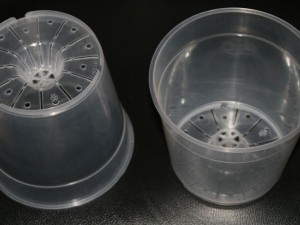
You can make a similar pot with your own hands.
It is necessary to take care of the pot in which the flower will grow. For those who have just decided to purchase an orchid, you should know that it will not grow in an ordinary flower pot.
This means that it is necessary to create the appropriate conditions for growth.
The pot should be made of clear plastic. It is necessary to make holes on it on the sides and bottom. It is desirable that small legs from 0.5 mm are present. This is done so that air flows to the roots of the plant. Some types of orchids prefer to grow in baskets that are hung from the wall.

Orchid Vanda in a hanging pot
Note: The orchid is sold in a transparent pot with air holes.
Soil preparation
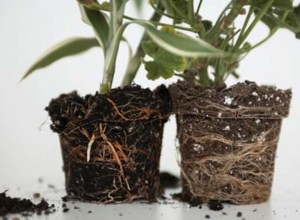
The orchid should be freely removed from the pot along with the soil.
An orchid will not grow in the ground. No matter how high quality and nutritious it is. In the wild, this flower (orchids - epiphytes) grows on trees high from the soil.
The same conditions must be created at home.
You don't need to rack your brains over this. The stores sell ready-made substrates for orchids. It is a mixture of sphagnum moss, pine bark, high-moor peat, a small amount of charcoal. Additional components are added to these main components. Therefore, the substrates are different.
It is important to know: the amount of charcoal should not exceed 5%. Since over time it accumulates salts, which negatively affects the growth of the flower.The soil should lie freely in the pot, it should not be tamped.
Where to put the flower

Side light is one of the conditions for proper orchid cultivation
Orchid is a plant that makes you admire yourself. Each hostess is proud of her favorite and wants to put it in a prominent place.
In this case, the following points should be taken into account:
- the orchid loves a lot of light, but it should be diffused;
- it is better to put the flower not on the windowsill, but to allocate a special stand for it, which should be placed on the side of the plant;
- after winter, the orchid weaned from bright sunlight, for a while it needs to be shaded.
Note: if the leaves turn pale, turn yellow, the roots stretch out, then the orchid does not have enough light.
Temperature regime
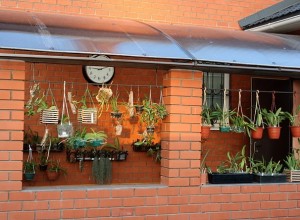
The orchid on the loggia in the summer feels great
Orchid is a heat-loving flower.
The room temperature must be at least 15 degrees Celsius. Otherwise, the flower may simply freeze. At high temperatures, the flower feels much more comfortable. But there are some nuances.
If the air temperature is over 25 degrees, so-called "babies" will begin to appear on the orchid. These are small shoots on shoots, roots. As they develop, they can be detached from the main flower, and transplanted into a separate pot. Sometimes such conditions are created on purpose.
Note: You can take the orchid out into the fresh air in the warm season in the morning and in the evening. The scorching sun can scorch the leaves and the plant dries up.
Watering the orchid

Watering the orchid is best over the sink.
In the case of an orchid, the rule applies: it is better to underfill than to overdo it. In the warm season, it is enough to water the flower once a week. In winter, once every 14 days.
There are 3 methods:
- Pour water into a pot - pour the liquid around the edges. Watering should be abundant. Residual moisture flows out through the holes.
- Submerge the pot in water - immerse the entire pot to the brim for 30 minutes. Then they put the water on the glass.
- Spraying - the whole plant is treated, except for the inflorescences. From the presence of water, they fade, wither, spots appear. Care must be taken to ensure that the water does not stagnate in the leaves.
Very important: the water should be at room temperature or slightly warm.
Soft water can be used from the tap. Before that, she insists for a day. Hard - boil, and then also defend. If the orchid likes acidic soil, add a few drops of vinegar, citric acid or juice.
Plant transplant

The new pot shouldn't be too big
The orchid does not like frequent transplant procedures. The optimal period of time is 2 years. This should be taken into account when choosing the size of the pot.
The best time of the year for this is spring and early summer.
The orchid transplant procedure itself includes the following steps:
- water well the day before;
- gently remove the orchid from the pot;
- place in water so that the soil is soaked;
- view the roots - cut off spoiled or with the presence of rot, treat the tips with activated carbon;
- place in a new pot and add a new substrate;
- water only after 1-2 days.
Attention: should not be replanted when the orchid is in bloom or the roots have resumed growth after winter. You can tell by the tips of the roots - they turn bright green.
The plant itself will say that the time has come for transplantation. The roots will stick out from above, become thin, the leaves will no longer be saturated. It seems that the orchid has little space.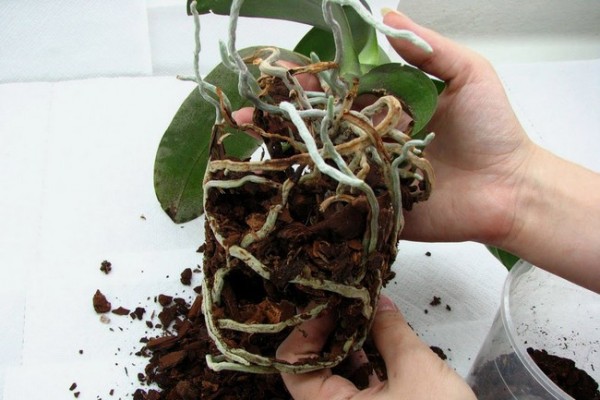
Post-flowering care
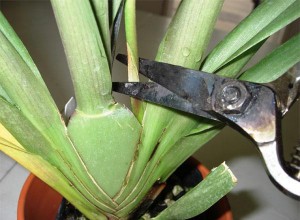
The scissors must be sharp so that there is no dent on the shoot
The orchid is distinguished by long flowering. Some species stand in flowers all year round (for example, the Phalaenopsis orchid). On average, this takes 6 months. The buds open gradually. What to do with the stem after flowering?
There are 2 options: cut it off or wait until it dries.
The second option is more appropriate.New flowers may appear on the stem, the formation of which may not be noticeable at the time of cutting. It is better to wait until it dries up, and then carefully cut it off. Interestingly, with such care, the orchid will bloom much faster than when the stem is cut off right away!
Reproduction at home
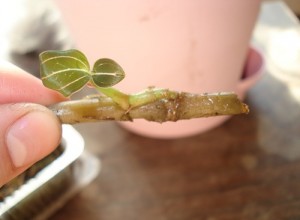
It looks like a cutting, ready for transplant.
Breeding orchids is a process that requires neatness, sterility and aging.
There are several ways to dilute a greenhouse of flowers from one plant:
- Reproduction by division. The flower is removed from the pot, soaked. A sharp knife is used, which is previously disinfected or pierced over a fire. The flower is carefully cut into 2 parts. The cut site is treated with activated carbon.
- Propagation by cuttings. Suitable for fast growing orchids with one apical point of growth. Young shoots are used. The knife is pre-prepared. Cut at the base of leaf growth. Cuttings are cut into 20 cm each. The ends are treated with activated carbon. Then it is necessary to dry in the open air for 1 day. The substrate should be light. The day before transplanting the cuttings, it should be well moistened. Next, you need to arrange them correctly. Do not stick, just lay on top of the substrate. Make a greenhouse. Just cover with plastic wrap. To create conditions of high humidity and warmth. When leaves and roots appear, you can transplant.
- Orchid propagation by seeds at home is almost impossible to carry out. Complete sterility must be observed. And everything. A special temperature regime is created. The composition of the substance in which the seed will develop. Moreover, the seed of the orchid is very small - the size of a speck of dust.
- Reproduction by children. One of the easiest and safest options. At elevated air temperatures, leaves and new roots appear on the shoots, which grow in different directions. These are kids. It is necessary to provide the flower with high humidity. After the neoplasm gets stronger, you can cut it off and transplant it into another pot. Another breeding option is to gently bend the shoot into another pot of soil and sprinkle it. After it takes root, cut it off.
You can find out more useful information about the methods of breeding orchids at home from this article.
The orchid should feel cared for, warm, calm at home. Then she will delight with excellent flowers and become a talisman of good luck for her mistress or master. Orchid care is no different from other flowers, it's just special.
Look video tips for growing orchids at home:
Rate the article:
(0 votes, average: 0 out of 5)
Hard to believe, but orchids are not much younger than ferns. They existed 130 million years ago. Perhaps no flower has overgrown with so many legends as the orchid. In one of them, it is said that the beautiful Aphrodite, running through the forest, lost her shoe, and in this place an equally beautiful flower, an orchid, grew.
Another tells of a broken rainbow, from the fragments of which orchids grew.

For a long time it was believed that breeding them is possible only in greenhouses. Now indoor plant lovers are proud to showcase the collection of orchids grown on the windowsills of city apartments.
Orchid - flower description
Pseudobulb
It is a seal on the stem that contains a supply of water. It is located almost at the root, it is from there that peduncles and leaves come. In shape, pseudobulbs are spherical, ovoid and cylindrical.
Leaves
Collected in a basal rosette, dense, green, oblong, at the same time wide enough.
Roots
They have a flattened shape, using which they stick to any plant.
Growing features
For a long time, the orchid was considered a difficult flower to grow at home. Now the situation has changed. The orchid is now a completely home flower. For successful cultivation, a little experience and practical knowledge are enough.
Planting an orchid at home

An orchid bought in a store does not always need to be transplanted, but only in a few cases:
- the flower does not keep in the pot, reasons: the leaves have grown on one side - you need not just transplant the orchid, but make the pot heavier or choose a heavy glass pots;
- if there was sphagnum moss in the shipping pot;
- if another pot is prepared for the orchid.
- there is little soil in the container, and the flower sways - fill up the substrate or transplant the orchid;
- root problems are visible through the transparent walls - the orchid must be urgently removed, bad roots removed, the cuts should be sprinkled with charcoal and replanted; if there are few healthy roots left, then the peduncle will have to be cut, otherwise the plant will die, the roots will not be able to fully provide it with nutrition;
Planting methods
The orchid is planted in a transparent pot, because its roots participate in photosynthesis on a par with leaves. There should be many holes at the bottom for water intake and excess drainage. The orchid pot can be plastic or glass. For step-by-step instructions on how to plant, see the Orchid Transplant section below.
Optimal planting time
The best time to plant is spring.
Soil for planting
Orchids are not suitable for ordinary soil: their roots are used to receiving a lot of air, at home most of them grow on trees. It is better to buy a ready-made orchid substrate. Then the plant is guaranteed normal air permeability. If this is not possible, you can mix pine bark chopped into small pieces (pieces about 1-2 cm in size) with garden soil.
The bark must be boiled within an hour. Crushed charcoal is added to the mixture.
Features of orchid care

In the process of caring for a plant, there are three main components: light, watering, temperature.
Location and lighting for the plant
Properly organized lighting is the key to successful orchid breeding. They need a lot of light, but it should be diffused, soft. In summer, sunlight is filtered using curtains or special filters that are glued to the window.
In the fall, you can let the sun's rays into the room: they will no longer be able to burn the delicate leaves of the flower. In winter, it is not only necessary to remove everything that interferes with natural light, but also to supplement it with artificial light. Daylight hours for orchids lasts up to 12 hours.
It is desirable that orchids stand on the southern windowsill, especially from autumn to spring, but they do well in the southeast and southwest, although there will be a problem of additional lighting. With good artificial light, some types of orchids feel comfortable on northern windowsills. Orchids can be taken outside, but do not forget to shade in time and do not expose to a draft.
Air humidity
Plants need high humidity. It is useful to spray regularly, increase the humidity in different ways, but only in a warm room. With cold content and high humidity, the orchid can rot the roots. Under any conditions it is necessary to provide care for orchid leaves by carefully wiping them with a damp cloth and spraying them.
When growing miniature orchids, the problem with moisture is solved simply. It is convenient to grow them in an aquarium. At the same time, watering is minimized: they have enough moisture in the environment for a long time and its supply in pseudobulbs.
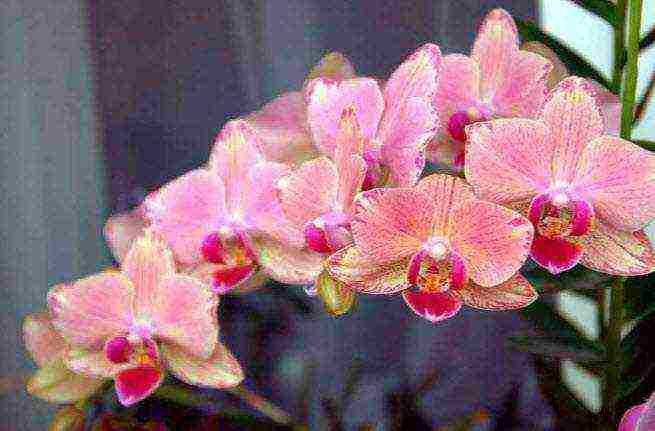
Temperature regime for orchids
To choose a temperature for orchids, you need to know that different types of plants prefer different temperatures. You can distinguish:
Heat-loving
They need a high temperature, reaching 30-32 degrees in summer and not dropping below 20.In winter, they grow at 15-18 degrees, but the difference between day and night temperatures should not be more than 3-4 degrees. These orchids are native to tropical forests: they are mainly phalaenopsis, dendrobiums, and some varieties of Cattleya.
Growing at medium temperature
In summer they will be satisfied with a temperature of 18-25 degrees, in winter 12-15. These orchids were once brought to Europe from the tropics, but from the mountains and foothills, hence the low growth temperatures. These are miltonia and odontoglossums.
Cool temperature lovers
In summer, such orchids will grow successfully at a temperature of 18-22 degrees, and in winter, 10-13 is enough. They are from highlands and subtropical regions. Australian dendrobiums, almost all papiopedilums.
But most orchid owners bought them in the store or received them as a gift, again the donor bought them, as a rule, at the nearest flower kiosk. They themselves and their ancestors were raised in Europe, most likely in Holland, and will feel great at temperatures of 20-27 degrees in summer and 15-18 in winter.
Orchids get sick stuffy in rooms: the room should be regularly ventilated. But you can't make drafts.
How to water properly
To organize the correct watering, you need to have a good idea of the conditions under which the orchids grew in nature. And bring watering as close to natural as possible:
- all orchid plants are epiphytes, therefore, they can easily endure a short break in watering, but this should not be allowed often: the leaves of the orchid will begin to wrinkle;
- some orchids (phalaenopsis, cymbidium, pafiopedilum) like the substrate to be constantly slightly moist; others (oncidium, dendrobium, cattleya) require the soil to dry out first;
- the water should be soft and warm; ideal rain or thawed warmed up; tap can be boiled;
- it is better not to water the plant from above, but put it directly in a pot in a bowl of water and leave for a few minutes, then take it out, let the water drain.
Fertilizing and fertilizing a flower

Ideally, you don't need to fertilize your orchid. She has enough supply of nutrients available in the substrate. But then the flower should be transplanted regularly every two years.
If there was no transplant, then it is better to add top dressing. You cannot take any fertilizer for flowers. They only need special ones for orchids. It is necessary to strictly observe the proportions named in the instructions. Fertilizers are applied during the flowering period once a week.
Pruning orchids
Orchids are pruned after flowering.
Pruning methods
After the orchid blooms along the main axis, you can cut the peduncle, leaving up to 5 buds from the leaf outlet. Then flower stalks can develop from the buds below the cut, and flowering will continue. When the plant has completely faded, all peduncles are cut off.
Orchid transplant
The flower is transplanted every two years to replenish the nutrients in the substrate. If the pot has become small, then it is transplanted more often. The plant is transplanted in the spring, but this cannot be done if the orchid has released a peduncle. It may not bloom.
Transplant methods
Transplantation raises many questions for novice florists. Here you need to follow a certain algorithm:
- carefully separate the walls of the pot and the root ball with a sharp narrow knife (the roots can grow into the pot);
- clean up old soil and cut off dead and rotten roots;
- pour a little soil into a new planter;
- install the plant in a pots, trying to keep it in the middle;
- gently spread the roots, they are brittle;
- first, little by little fill the voids between the roots, then the entire pot to the very edge, shaking it from time to time so that the substrate fills everything evenly;
- lightly crush the soil from above with something flat, for example, a spoon;
- After transplanting, the orchid is placed in a warm place and watered little by little.
Orchid propagation
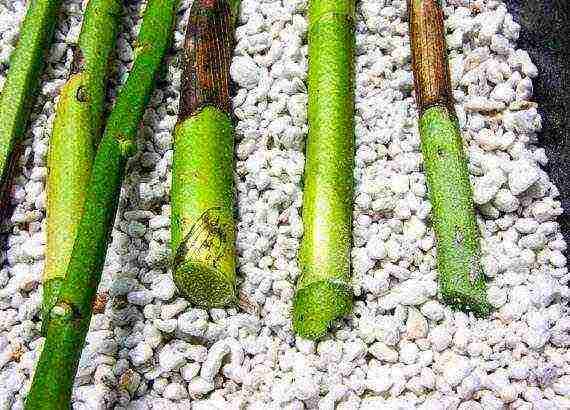
It is not difficult to reproduce it at home if you have certain knowledge.
Reproduction methods
There are two main ways: by seed and vegetative propagation. When propagating by seeds, you may not get a plant that is the same as the parent.
Division
This method works if the plant is large. Then the rhizome itself disintegrates during transplantation. It can also be divided:
- the orchid is taken out of the container and the roots are thoroughly cleaned from the soil;
- with a knife, which has been previously disinfected over an open fire, divide the rhizome between pseudobulbs;
- the sections are powdered with charcoal;
- flowers are planted in pots according to the method already described.
It is better to do this in the spring.
Propagation by cuttings
Not all species can be divided this way, but some, for example, Vanda, succeed.
The apical shoot is separated with a sterile knife, the cut point is dipped in crushed coal and planted in a pot.
Reproduction by children (stem offspring)
Many flowers, for example, phalaenopsis and dendrobium, give side shoots, babies. If such a baby has formed, then it should be protected, sprayed often and patiently wait for it to give roots. Then it is separated and planted in a container, sprinkling the cut with coal.
The appearance of such a baby can be provoked. This requires: high room temperature and nitrogen fertilization.
Reproduction by layering (pseudobulbs)
The pseudobulb is carefully separated and, after coal treatment, is planted in the ground. Further care is watering.
Seed propagation
Orchid seeds are very small, this is the main difficulty of such reproduction. It is used only by those who are engaged in selection. The seeds are placed in an artificial nutrient medium under sterile conditions so that molds do not develop, and germinate within 3-9 months. Then they are planted in a substrate and wait another 2-3 years until the plant can be transplanted. Orchids grown from seeds bloom only after 3-4 years.
Orchid bloom

They buy a blooming orchid in the store. Therefore, each owner faces two acute questions: is it possible to make it bloom for a long time and how to force it to bloom again if it faded quickly.
When the orchid blooms
They bloom when they reach the age of 1.5-2.5 years.
In order for the orchid to please with flowering, it is necessary to create certain conditions for it:
- provide a long daylight hours, the orchid must lay the required number of buds and form peduncles, this is a long process;
- be sure to need drops in day and night temperatures, during this period they can reach 5-7 degrees.
But if the orchid does not want to bloom, you can try to force it by arranging extreme conditions of detention:
- keep it for 15-20 days at a temperature of 15-17 degrees;
- significantly reduce watering during this period.
In different types of orchids, flowers differ markedly both in shape and in shades of color. But there is also something in common: the lower petal resembles a lip in shape, there are two sepals on its sides, two side petals rise above them, and the upper sepal completes all this.
Orchid care during flowering
An orchid, depending on the species and how many buds were laid in preparation for flowering, can bloom from 2 to 10 months. During this period, watering is doubled, the air temperature should be at least 20-25 degrees.
Orchid care after flowering
First of all, the peduncle is cut to give the opportunity to form a new one. The orchid can be fed, followed by the usual care.
Pest disease problems

Diseases:
- anthracnose - manifests itself as brown spots with dots on the leaves; it is treated with preparations containing copper;
- fusarium - rotting spots appear on the leaves, this happens due to excess moisture — they are transferred to a dry room and watering is stopped;
- rust - rust spots on the bottom of the sheet — cannot be treated; the plant is destroyed so that others do not get infected;
- black rot - sprouts and leaves die off, the reason is in a too cold room - it is better to destroy the plant so as not to infect the rest.
Pests:
- aphid - destroyed by a mixture of milk and water in equal proportions;
- soft mite - the affected areas in the form of rosettes are cut out and sprinkled with ash along the edge;
- spider mite - the whole plant, window and windowsill are thoroughly washed with soap;
- scabbards - live in growths and bumps, get rid of them with the help of soap suds;
- thrips - translucent bugs living at the bottom of the leaf, cut out the affected areas.
If such methods do not help, then they turn to chemicals and process the plant according to the instructions.
Popular species (varieties)
- Phalaenopsis orchid—The most widespread species in indoor floriculture, there are many hybrids on sale that successfully grow in the house;
- Dendrobium nobile orchid - there are many varieties, they all bloom in spring, the most popular is white orchid, such plants, which have a pure white color, come from Thailand;
- Cambria orchid- an artificially bred plant, it blooms for a long time, grows well on the windowsill;
- Ludisia orchid—A plant with very beautiful leaves, grows indoors only with very high humidity;
- Miltonia orchid- Difficult to breed, but with very beautiful fragrant flowers, similar in shape to pansies;
- Cymbidium orchid- very large plants, now miniature varieties have been developed that are so easy to care for that they are offered to novice growers;
- Cattleya Orchid- a species with spectacular waxy flowers, hybrids of which grow successfully in rooms;
- Wanda orchid - successfully grows indoors up to a meter;
- Oncidium - flowers resemble butterflies, grows in the house, but with strict adherence to the rules of care.
Useful tips (note to the florist)
- If the bathroom has a large enough window, then this is the optimal place for the orchid.
- It is better to buy orchids in spring or summer.
- If the flower has given aerial roots, then they must be sprayed.
- After the orchid has faded, it must be rearranged to a new place.
Answers to readers' questions

What is the lifespan of a plant?
Each species has its own lifespan. At home, orchids live from 3 to 10 years.
Can this plant be kept at home?
This flower will be a decoration for any home.
Is this flower poisonous?
This houseplant is not poisonous.
Why isn't the orchid blooming?
No preparatory measures were taken.
Why do the leaves turn yellow (dry)?
The reason is most often an excess of moisture or a lack of it.
How does the plant overwinter?
Winters in a cool room with an average temperature of 15 to 18 degrees and limited watering.
Orchids are graceful and sophisticated flowers that have gained particular popularity among indoor plant lovers. They are adapted to grow in an ordinary city apartment and bloom beautifully. While it is generally believed that growing orchids is incredibly difficult, caring for them is not so cumbersome. For a competent plant breeder, the cultivation of this flower will not be difficult. If you were presented with such a miracle of nature, and you want it to feel good, you first need to find out what kind of variety it is. And then it is advisable to learn how to grow orchids at home.  This article will cover the basic principles of breeding these gorgeous flowers.
This article will cover the basic principles of breeding these gorgeous flowers.
How to grow orchids at home? Temperature regime and lighting features
There are two methods for breeding these flowers:
- Traditional. It consists in alternating periods of growth and dormancy, while the latter is quite long and varies by the grower so as to prepare the plant for development at the most favorable time.
- Intensive (used in industrial cultivation). It implies the resumption of active watering immediately after the dormant period has passed, in order to obtain active plant growth several times a year.
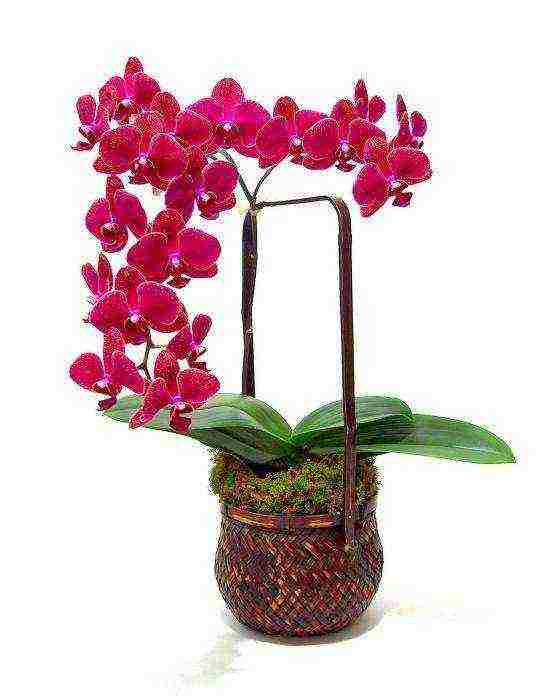 Both of these methods have their own advantages. It is up to you to decide exactly how to grow your orchid.The first method allows you to get a strong, healthy plant, but over a fairly long period of time. The second shortens the time, but the risk of the death of the flower is quite high. How to grow orchids at home? What does this beautiful plant require for long flowering? Of course, this is the right lighting. The orchid loves light, but does not tolerate the scorching direct rays of the midday sun. Therefore, it is advisable to place the beauty on the west, east or north window. If you notice that its leaves have darkened, then this indicates a lack of light. Conversely, if they turn yellow and become stained, there is too much of it. In addition to lighting, the orchid is very demanding on the room temperature. For each variety, a special range of indicators is intended, within which the flower feels good. Therefore, it is advisable to purchase a thermometer with a hygrometer. In general, most varieties require an air temperature between 20 and 25 ° C. For flowering phalaenopsis, a difference between day and night temperatures of 5 ° C is required. This plant is the most thermophilic, in winter it needs a regime of at least 15 ° C. For the Cattleya variety, the night temperature should vary between 12-15 ° C, daytime - 18-22 ° C. There are orchid species that require coolness (from 10 ° C to 12 ° C), as well as a significant drop in night temperatures, down to 12 ° C. Without such differences, varieties such as Tselogin, Lelia, Miltoniopsis, Masdevallia, Rossoglossum, Cymbidium, Likasta will not grow and bloom.
Both of these methods have their own advantages. It is up to you to decide exactly how to grow your orchid.The first method allows you to get a strong, healthy plant, but over a fairly long period of time. The second shortens the time, but the risk of the death of the flower is quite high. How to grow orchids at home? What does this beautiful plant require for long flowering? Of course, this is the right lighting. The orchid loves light, but does not tolerate the scorching direct rays of the midday sun. Therefore, it is advisable to place the beauty on the west, east or north window. If you notice that its leaves have darkened, then this indicates a lack of light. Conversely, if they turn yellow and become stained, there is too much of it. In addition to lighting, the orchid is very demanding on the room temperature. For each variety, a special range of indicators is intended, within which the flower feels good. Therefore, it is advisable to purchase a thermometer with a hygrometer. In general, most varieties require an air temperature between 20 and 25 ° C. For flowering phalaenopsis, a difference between day and night temperatures of 5 ° C is required. This plant is the most thermophilic, in winter it needs a regime of at least 15 ° C. For the Cattleya variety, the night temperature should vary between 12-15 ° C, daytime - 18-22 ° C. There are orchid species that require coolness (from 10 ° C to 12 ° C), as well as a significant drop in night temperatures, down to 12 ° C. Without such differences, varieties such as Tselogin, Lelia, Miltoniopsis, Masdevallia, Rossoglossum, Cymbidium, Likasta will not grow and bloom.
How to grow orchids at home? Soil and irrigation regime
 This plant is quite demanding on the soil. When kept at home, it is advisable to purchase a special substrate for orchids or make it yourself from materials that retain moisture well (tree bark, sphagnum moss, polypodium, coconut fibers, etc.). Watering the plant must be competent. The flower is moistened in summer every two or three days, and in winter - once (two) times a week. The substrate should dry well. How to grow an orchid correctly? It is important to water it rationally and in a balanced way, immersing the plant pot in a bowl of water for 10 minutes. During this time, the substrate will pick up liquid through the holes in the container. After that, the water is drained, and the pot stands for some time in an empty basin. Do not moisten the orchid on top, like all other indoor flowers. It is important to use settled warm water for irrigation. In addition, it is periodically necessary to spray the plant (in the morning or during the daytime), especially for an orchid standing close to a heating battery. It is a good idea to periodically give the flower a warm shower. The pot is placed in a bath and the plant is sprayed with a gentle stream from the shower, while the water temperature should be about 40 ° C. Then the orchid is allowed to dry and the center is blotted to prevent it from rotting. You can "bathe" a beauty only when she is not blooming!
This plant is quite demanding on the soil. When kept at home, it is advisable to purchase a special substrate for orchids or make it yourself from materials that retain moisture well (tree bark, sphagnum moss, polypodium, coconut fibers, etc.). Watering the plant must be competent. The flower is moistened in summer every two or three days, and in winter - once (two) times a week. The substrate should dry well. How to grow an orchid correctly? It is important to water it rationally and in a balanced way, immersing the plant pot in a bowl of water for 10 minutes. During this time, the substrate will pick up liquid through the holes in the container. After that, the water is drained, and the pot stands for some time in an empty basin. Do not moisten the orchid on top, like all other indoor flowers. It is important to use settled warm water for irrigation. In addition, it is periodically necessary to spray the plant (in the morning or during the daytime), especially for an orchid standing close to a heating battery. It is a good idea to periodically give the flower a warm shower. The pot is placed in a bath and the plant is sprayed with a gentle stream from the shower, while the water temperature should be about 40 ° C. Then the orchid is allowed to dry and the center is blotted to prevent it from rotting. You can "bathe" a beauty only when she is not blooming!
How to grow orchids at home? Correct feeding and reproduction
In addition to timely watering and spraying, this plant also needs feeding. To do this, use specialized fertilizers that can be purchased at any flower shop. Do not use additives intended for other indoor plants. Top dressing is done once every 14 days during the growth and flowering of the orchid. With regard to reproduction, there are three possible breeding methods: division, cuttings and aerial roots. Division is considered one of the most convenient methods. How to grow an orchid from the root? To do this, you need to get the plant out of the pot. Separate the roots from the substrate and wash lightly. Then the rhizome is divided into several parts with a sharp knife, and the places of the cuts are sprinkled with activated carbon (crushed). The resulting plant elements are placed in a substrate and carefully looked after, just like an adult flower.For the division, a powerful and well-developed orchid is chosen.
 Gardening in Russia is a hobby that stops with the onset of cold weather. And only the cultivation of indoor flowers can be done year-round. One of the most spectacular and popular is the orchid. Few plant can compare with her beauty, graceful forms and variety of colors. But growing a tropical beauty is a rather complicated process, which should be taken up only after a thorough study of the theory.
Gardening in Russia is a hobby that stops with the onset of cold weather. And only the cultivation of indoor flowers can be done year-round. One of the most spectacular and popular is the orchid. Few plant can compare with her beauty, graceful forms and variety of colors. But growing a tropical beauty is a rather complicated process, which should be taken up only after a thorough study of the theory.
Choosing a flower
The easiest way to get a plant is to buy it from a specialty store. Today, the assortment in them is the widest, so it is not surprising to get confused. When choosing, one should focus not only on the beauty of the flower, but also on a number of other signs.
The health of the orchid will also depend on the condition of the roots. They should be developed, gray or green. The growing flower has a bright green root tip. The leaves are dense, without signs of lethargy. If they have a sticky coating, white or yellow spots, then you should refrain from buying.
To check how healthy the roots are, you can simply shake the plant pot.
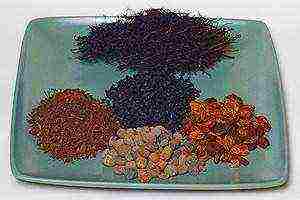 Orchids do not use ordinary garden soil. The soil should consist of a mixture of moss, bark, perlite, sand, cork.
Orchids do not use ordinary garden soil. The soil should consist of a mixture of moss, bark, perlite, sand, cork.
An adult plant that can multiply and bloom will cost more. The young seedling has few leaves, and it does not yet have a peduncle. He will release the flower only after a few years. If there is no desire to wait, then it is better to take a formed orchid.
Also
The necessary conditions
In order to properly grow an orchid, a number of prerequisites must be observed: properly prepare the soil, maintain the light regime, humidity, and transplant the flower on time.
 Since the orchid has a very long stem, the pot must provide her with reliable support... The soil consists of a mixture of moisture-retaining components, tree bark, a mineral-rich substrate (vermiculite), and literally a handful of earth is added. The soil retains moisture for a long time, supplies the plant with minerals.
Since the orchid has a very long stem, the pot must provide her with reliable support... The soil consists of a mixture of moisture-retaining components, tree bark, a mineral-rich substrate (vermiculite), and literally a handful of earth is added. The soil retains moisture for a long time, supplies the plant with minerals.
The pot should be elongated, not too wide, with a lot of holes. It can be replaced by an ordinary plastic container, which is placed in a decorative planter. But it is desirable to have a transparent pot itself - this will allow you to control the degree of soil moisture, monitor the development of roots.
A container with a growing seedling should not be placed on the south window! The leaves will get sunburn. Better to move it to the center of the room, place it on a table or stand. But you can place an orchid on the north or east window.
Temperature and watering
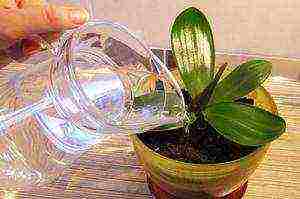 Under natural conditions, the orchid has managed to spread throughout the globe and feels great in different climatic zones, up to the Arctic Circle. But most of the varieties still come from warm countries: Australia, South America, Malaysia, Brazil. To grow this delicate flower better, you should find out which climatic zone it comes from.
Under natural conditions, the orchid has managed to spread throughout the globe and feels great in different climatic zones, up to the Arctic Circle. But most of the varieties still come from warm countries: Australia, South America, Malaysia, Brazil. To grow this delicate flower better, you should find out which climatic zone it comes from.
The optimum temperature is considered to be 18-27 ° С during the daytime, at night - up to 24 ° С. Ideally, in the dark, you should transfer the plant to a cooler room. This will allow him to develop faster. By the way, it perfectly tolerates small temperature changes. Only in the event of a cold snap, it is necessary to reduce watering (and vice versa).
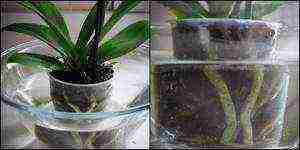 There is original way of watering... A larger container is taken, water with fertilizer is poured into it. Then a pot of orchid is immersed there. Within 15 min. the soil must be saturated with moisture, after which the plant is taken out.
There is original way of watering... A larger container is taken, water with fertilizer is poured into it. Then a pot of orchid is immersed there. Within 15 min. the soil must be saturated with moisture, after which the plant is taken out.
- Like many other flowers, the orchid does not tolerate direct sunlight, it needs diffused lighting.
- There is no need to fill the pot, this can lead to irreversible consequences - wilting. The amount of water should be slightly increased during the onset of the growth phase.But after flowering and in winter, watering is reduced.
It is necessary to fertilize orchids constantly - it is better to do this with the help of specially created fertilizers. They should be diluted and applied according to the instructions. Tough, durable leaves, gray-green roots indicate that watering is not required yet. But if the container is small, moisture will evaporate from it faster. Therefore, the frequency of watering is determined by the situation.
Reproduction and transplantation
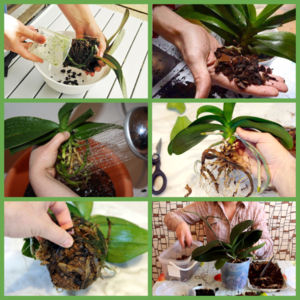 If growth is proceeding correctly, it is time for a transplant. Often it is not recommended to carry out it, as it is a stressful situation for the gentle inhabitant of the pot. After a change of residence, growth may stop for a short time. But once every 3 years it is necessary to do this, the best time is spring. You will need a pruner, a new soil mixture. The instrument must be disinfected so as not to infect.
If growth is proceeding correctly, it is time for a transplant. Often it is not recommended to carry out it, as it is a stressful situation for the gentle inhabitant of the pot. After a change of residence, growth may stop for a short time. But once every 3 years it is necessary to do this, the best time is spring. You will need a pruner, a new soil mixture. The instrument must be disinfected so as not to infect.
- The pot should be slightly crumpled in your hands - this way the rhizomes are easier to separate from the walls. They must be cleaned of old soil.
- After careful examination, remove insects, damaged areas of the root system, lower leaves.
- The flower must be dried for several hours.
- Before planting an orchid in a new pot, it must be treated with an antiseptic. The growth point is left on the surface.
- It is not necessary to tamp it too tightly - the soil should be airy.
 Anyone who has managed to achieve flowering from a young flower will want to have a few more. In order to grow an orchid at home, there are several options.
Anyone who has managed to achieve flowering from a young flower will want to have a few more. In order to grow an orchid at home, there are several options.
Some species reproduce in only one way - side shoots, or bulbs... But the simplest method is division... Therefore, beginners should choose a variety for which it is suitable. Distributed and grafting.
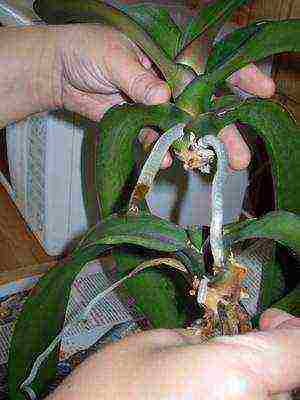 It is better to cut off the shoots that were closer to the base - the plants that will appear from them will be the most powerful. On each separated piece, 2-3 buds are left, no more needed. Sections must be processed with crushed coal... Then the planting material is placed in tree bark or sphagnum moss (they must first be moistened). They are looked after as for an ordinary orchid. The first roots will appear in a month.
It is better to cut off the shoots that were closer to the base - the plants that will appear from them will be the most powerful. On each separated piece, 2-3 buds are left, no more needed. Sections must be processed with crushed coal... Then the planting material is placed in tree bark or sphagnum moss (they must first be moistened). They are looked after as for an ordinary orchid. The first roots will appear in a month.
By dividing the bush, only those specimens that have reached the age of several years and are sufficiently strong are propagated at home. Necessarily air roots are required, at least three, and it is better if there are also new ovaries. The sections are treated with crushed coal, then planted in new pots, the soil is changed. After a while, the flower will grow.
Rarely, some species produce additional shoots. Small outgrowths appear slightly away from the main root. The shoot is carefully removed after abundant watering, planted in a separate container. Grown as usual.
Growing orchids from seeds at home is an impossible task! Many novice florists take it up, but to no avail. It is much safer to plant cuttings or divide an already matured plant. These are proven methods that many hobbyists use successfully.
By starting with just one flower, you can gradually expand your collection. If home conditions are favorable, the orchid will bloom for a long time and reproduction will be successful.
Orchid diseases
They are divided into several types. Treatment is usually long and not always effective, so it is better to strictly follow all the requirements so that the plant grows healthy.
 Fungal diseases... Small brown spots indicate anthracnose. They gradually increase, becoming covered with mucus. The reason is excessive moisture. The affected areas will have to be removed, the sections processed.
Fungal diseases... Small brown spots indicate anthracnose. They gradually increase, becoming covered with mucus. The reason is excessive moisture. The affected areas will have to be removed, the sections processed.- Powdery mildew recognizable by whitish bloom. The affected area dries up and dies. The reason also lies in the excessive moisture content of the soil. Sulfur solution is used as a medicine.
- Bacterial infections... Poorly treatable. They appear as spots on the leaves, which become ulcers.Infected parts are cut off, capturing healthy tissue.
- Viruses... The first sign is the appearance of spots that resemble a mosaic, forming circles and stripes. The diseased flower will have to be destroyed, because the treatment will not give results. Fortunately, viruses are rare.
 Orchids captivate many lovers with their delicate beauty. Many believe that only experienced gardeners can grow them at home, but this is not the case. If you take the necessary measures on time, following the rules, it will be possible not only to grow an orchid and achieve its flowering, but also to propagate the plant.
Orchids captivate many lovers with their delicate beauty. Many believe that only experienced gardeners can grow them at home, but this is not the case. If you take the necessary measures on time, following the rules, it will be possible not only to grow an orchid and achieve its flowering, but also to propagate the plant.
Attention, only TODAY!


